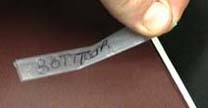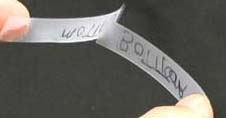|
Electric Charges
|
|
|
| Seat Experiment |
|
Tear about 10 cm of clear tape from dispenser. Stick the tape to a binder or other smooth surface and carefully peel it up. Have a partner do the same. Bring your tape close to your partner's tape. Q1: Describe and sketch the interaction. Does the strength of the interaction change with the distance between tapes? |
 |
 |
To your binder or a smooth plastic surface attach a 12 cm piece of tape and label it "bottom." Place a 10 cm piece of tape labeled "top" onto the first. Peel up both together. |
| While still together, stroke the two pieces of tape with your thumb and index finger to discharge them. Finally, carefully peel the two apart. Determine how the top an bottom pieces interact. Now test your pieces of tape with that of other groups. |
|
Q3: Describe and draw the interaction between your bottom and top tapes and those tapes prepared by other groups. Do they behave consistently? How many others did you try? Q4: From your observations, what evidence supports the claim that two distinct types of charges exist? Q5: Account for these phenomena using the 'electron fluid' model of charge behavior by sketching diagrams of the pieces of tape with charges in your report. Describe in words what tape has what charge and where it came from. Q6: Describe the interaction between your bottom and top tapes in terms of conservation of charge. Advanced Question 1: Can you sketch and describe an experiment which could (very crudely) determine the number of excess electrons on a piece of charged tape? Sketch your experiment. Here are some hints: |
| References |
| Chabay & Sherwood, Electric and Magnetic Interactions,
Carnegie Melon University Priscilla W. Laws, Workshop Physics, Dickinson College |
|
|
|
|
